Policy Interventions Needed to Reduce Economic Inactivity in Northern Ireland

Dr Ka Ka Katie Tsang
An unprecedented number of older people have left the UK workforce since the beginning of the pandemic. Evidence from the Institute for Fiscal Studies suggests increased rates of inactivity can be linked to poor health, and pandemic-related job redundancies and dismissals.
Older People and pandemic losses
In the face of a public health emergency, lockdown restrictions induced a series of knock-on effects for economic activity and the Northern Ireland labour market. The Economic Policy Centre at Ulster University, Belfast say these ‘shocks’ to the NI economy have resulted in province wide changes to working practices, furlough and redundancy policies and a surge in the number of people claiming unemployment benefits. Since then, unemployment figures and economic inactivity have continued to increase significantly.
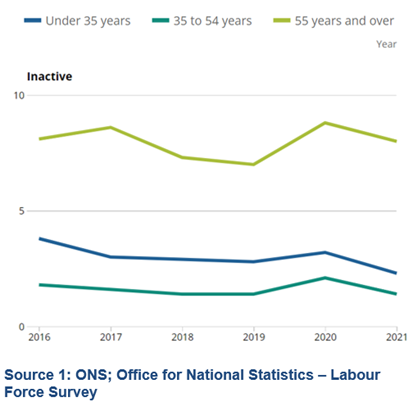
According to the Office for National Statistics (ONS), hospitality workers accounted for a third of UK job losses during the pandemic including redundancies which disproportionately affected older people.
People aged 55 years and over were most likely to become economically inactive because of earlier retirement and to a lesser extent because of higher rates of redundancy. In the years preceding the outbreak of Covid-19, this rate had begun to reduce however the pandemic reversed this. In England, Scotland and Wales, the rates of economic inactivity increased during the pandemic by a total of 4% compared to an 11% surplus in Northern Ireland.
Notably, the proportion of economically active people due to sickness or disability increased by 15% in Northern Ireland compared to 10% across other parts of the UK. Today the rate of economic inactivity has remained consistently higher than other working age populations in the UK. Although, the overall rate of economic inactivity in Northern Ireland has reduced to 25.8%.
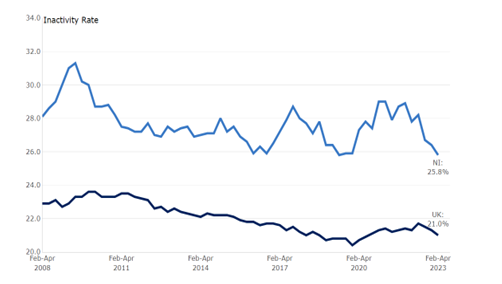
NI economic inactivity consistently above UK average (Feb 2008-Feb 2023)
This demonstrates some progress to a target set by the Belfast Economic Inactivity Strategic Framework, to reach 23% by 2030. Previous consultations from the Belfast City Council identified older people and the following groups as high contributors to inactivity;
- The long-term sick;
- People with disabilities;
- Women and lone parents;
Since the pandemic, the rate of people aged 50 and over in UK employment has declined and rates of economic inactivity have remained consistently high as seen below.
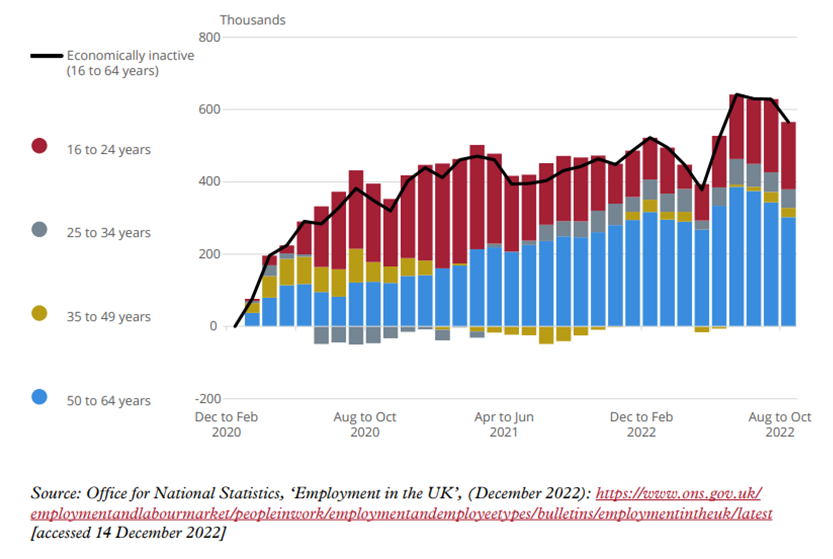
Cumulative change in 16-64 who are economically inactive since December-February 2020.
Of the 2.2 million of people aged 50 to 64 years in the UK, over one third of people said they left their last job due to retirement reasons while 21% of older people left due to health reasons.
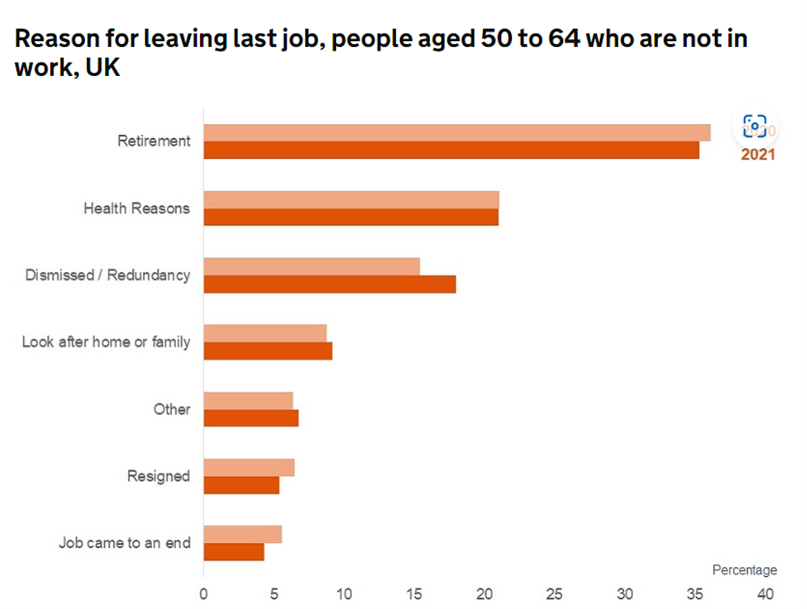
Department for Work and Pensions
Explaining higher inactivity in over 50s
In the UK, just over a quarter of all 50-64 year olds are economically inactive. Researchers observed that more over 50s who stated that since leaving their job during the pandemic, they had no intention of working and most had transitioned from work directly into inactivity. In addition to retirement, a range of personal circumstances have also been identified with higher rates of inactivity;
- Health status;
- Financial circumstances;
- Working conditions;
- Work-life balance;
- Caring and unpaid work responsibilities
Retirement
In Ireland, just over 50% cited retirement or early retirement as their reason for leaving employment. Higher rates of retirement were more predominant for people in their 60s than in their 50s. Evidence from the Institute for Fiscal Studies indicates that this pattern is most prevalent for those with hourly wages based on part-time work and those who were self-employed.
Conscious decisions to retire early were also influenced by the decisions of their partners. The ONS found that nearly two thirds of those whose partner had already cited retirement as the reason they leave work.
One reason for this might be that those who work fewer hours are closer to retirement than those who work the average 35+ hours. Poor health was cited as a secondary reason for transitioning from work into activity but is not viewed as the driving force for inactivity in over 50s. It appears that decisions to retire early are more consistent with a lifestyle choice accelerated by the pandemic. It is possible that the adaptation to different behaviours and ways of working during the pandemic prompted many to reflect on their careers.
Financial stability
While there is limited information on the financial resilience of older retirees, a UK Work and Pensions Committee, raises concerns around the underestimation of potential lifespan and the longevity of retirement funds necessary. Additionally, as the cost of living crisis worsens and energy bills continue to spike – more and more older people may have to return to work or apply for financial supplements to survive.
Dismissal and redundancy also impacted older workers at the start of the pandemic.18% of over 50s were affected by covid-related dismissals/redundancies. Evidence from the UK Work and Pensions committee highlighted the role of redundancy payments enabling twice the number of 50-69 year olds to move directly into early retirement.
Over a quarter of furloughed employments were made to those aged 50 years and over (1.3 million), with 3 in 10 of older workers believing there was a 50% chance or higher that their contract would be terminated following the end of the scheme. While there is limited data to track transitions from furlough to inactivity – the trajectory towards decisions to retire were more likely for those who had already lost their job due to the pandemic.
Figures from the ONS over -50s Lifestyle Study indicate the limited sources of financial security for those aged 50 to 59 versus those aged 60 and above.
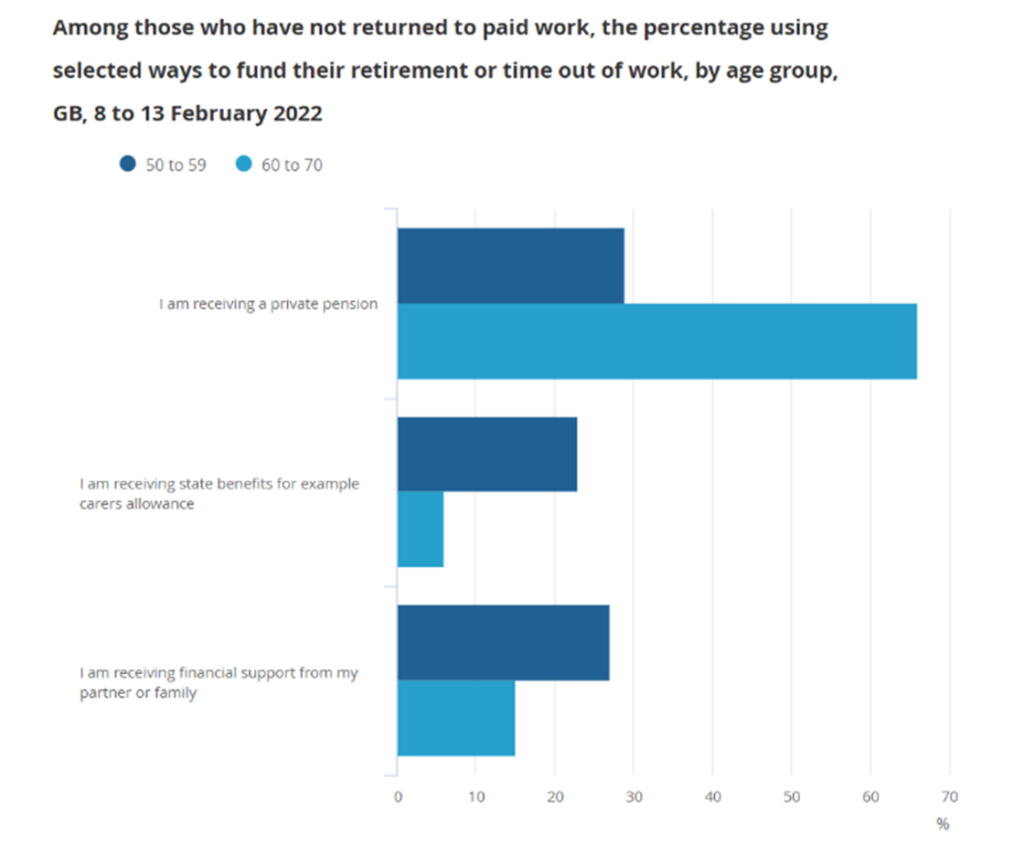
Office for National Statistics, Over 50s Lifestyle Study (OLS)
The ONS data indicates that older people aged between 50 to 54 were more likely to rely on state pension contributions, state benefits and financial support from their partner. Whereas older people aged 55 to 59 were more likely to rely on a private pension, the accruement of personal savings/investments or be dependent on a redundancy package. It is expected that older people within this group who are financially secure cannot be persuaded to work again. Moreover, increasing support and access towards pension flexibility may also enable many to transition from employment to inactivity out of choice. Other reasons for early transitions into retirement relate to the increasing stress of work and pandemic-related behavioural changes which include the fear of exposure to Coronavirus infection.
Employment profile of older people
Evidence from the Institute for Fiscal Studies found that the likelihood of re-employment following redundancy is significantly lower for older people than it is for those aged 16-24. The pandemic has increased the employment gap between older and younger workers, as older employees have left the workforce. Contributing factors and differences in social inequalities, training and qualifications may contribute to a lower count of newly employed workers over 50.
The UK Learning and Work Institute emphasised a mismatch between available roles and the types of work that older people want or are able to do. One way to reverse the shock effects of Covid-19 is to prioritise reskilling the furloughed and dismissed.
Involuntary employment losses remain a significant contributor to pandemic related labour exits as do chronic illness/disability and caring reasons. Policy interventions necessary to intervene in these cohorts should be multi-pronged and also target those on hourly wages and part-time hours. Policy solutions may require multi-level interventions not limited to including i) flexible work options to ensure low mobility individuals may continue to work and ii) access to lifelong learning for older people who are low skilled and organisational strategies to accommodate the multiple challenges which face those approaching their 50s in the workforce. A closer look at the employment profile of over 50s indicates that workers aged 50 and over in Northern Ireland had the lowest employment rate at 64%. The equivalent figure for Scotland and Wales is 69% and 71% in England.
Other changes in labour market behaviour were higher reports of fewer working hours than usual (including none) from Dec 2020 to February 2021 than those aged under 50 years. A recent University College Dublin report found that 1 in 5 workers aged 50 or over typically held low paid jobs or held part time contracts. It was also reported that older people had no choice but to return to work due to inadequate pension funds. The changing employment profile of older people in the workforce raises questions on the conditions and challenges of over 50s access to well-paid, full time positions.
Addressing deteriorating health and economic inactivity
The promotion of health holds significant value in enhancing employees’ well-being and prolonging their work ability. As stated by Kuoppala, Lamminpää, and Husman, health promotion is a process that empowers employees to have greater control over health-related factors, thereby improving their overall health. For older employees, several age-related physical and psychological changes come into play. Between the ages of 40–65, they may be affected by a decline in muscle strength, if not accompanied by a degree of physical activity with a further 10–25% decrease in muscular capacity by the age of 65.
Occupational health interventions can play a crucial role in reducing the risk of early workforce retirement. Job resources, such as the ability to leverage one’s strengths and potential, play a significant role in work engagement, which, in turn, has a positive impact on health. In Northern Ireland, there is limited evidence on health specific interventions
From the perspective of older individuals, a positive working life contributes to better health and work ability. Maintaining health, competencies, and skills becomes a crucial motivation for prolonging workforce participation, as illness can lead to suffering and decreased income. The desire for continued social interactions, financial rewards, appreciation, and the opportunity to face challenges at work are also reasons that drive older employees to continue working.
More than one health condition
Rates of employment and economic inactivity are also affected by the severity and counts of health conditions. Research from the UUEPC found that three-fifths (59%) of people with disabilities report their conditions severely limited their daily activity.
The employment rate for disabled persons with one health condition is 48% compared to only 15% for those with four or more chronic health conditions.
In addition, the 2022 Motability report found that one in five disabled people were unable to travel as there are no appropriate transport options available to them. Two thirds of those who do travel highlight experience regular difficulties in accessing reliable transport.
People with disabilities and the sectoral organisations cited the reduced transport requirement of home working made it easier for some as this was a specific barrier for those with mobility issues. They also noted that work is not as physically demanding when working from home. There is a reduced commute time and greater scope to manage certain conditions. It was noted that for certain conditions like MS people have the opportunity to take a short break / lie down during their lunch break – something that would not be as socially acceptable in the traditional workplace environment.
Studies have found interventions range from individual-level health checks and counselling for employees, interventions based on screenings, and improvements in the work environment. The implementation of health counselling can lead to positive future behavioural changes and reduced health risks, ultimately enhancing work ability. Yields from individual measurements and screenings is an effective way to monitor and track employees’ work ability and health status over time. Furthermore, supervisor training and support has been shown to positively impact health outcomes and increase work ability among its employees.
Evidence however also suggests that such interventions need to be implemented and used by younger age cohorts to maximise prolonged working in the future.
Disability and work-limiting health conditions
Rates of economic inactivity can be influenced by factors such as structural unemployment barriers, limited job opportunities in certain regions or industries, economic downturns, factors that discourage workforce participation and policies which incentivise older and younger people to remain on welfare benefits and social assistance.
In Northern Ireland, over one fifth of the population aged between 16-64 are disabled. At almost a quarter of a million people, this represents a significant proportion of the NI labour supply. During the pandemic, employment rates for people with disabilities were significantly lower than those without. In 2020, the employment rate for people with disabilities was 38.1% and rate for those without disabilities was 80.3%. The disability employment gap at this time was 42.2pps. As per the chart below, the gap widens as people get older.
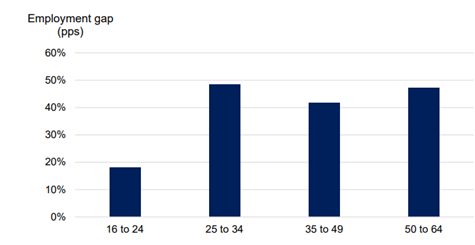
Source: Labour Force Survey
Northern Ireland has the lowest employment rate for people with disabilities within the UK. Statistics also reflect the largest UK employment gap. Recent figures from the Economic Policy Centre, Northern Ireland state that the disability employment gap has increased to 44 percentage points in comparison to people without physical or mental disabilities. Closing this gap remains a priority within the on-going creation of the Disability and Work Strategy.
Disparity in the employment outcomes for people with disabilities and those without point to evidence which reflects the additional barriers and constraints experienced when trying to access and stay within the labour market.
Differences in occupation, qualifications and working hours contribute to rising poverty levels within this group and variance in household income (see figure 1 below).
Disability benefits
Over one in five (23%) disabled people live in relative poverty, and almost two-fifths (38%) of people living in households experiencing poverty in NI include a person living with a disability. These inequalities are further exacerbated by a longstanding failure to reduce the number of disability benefit claimants. Those in receipt of ESA or income replacement benefit can also be placed into a support group where there is no obligation to participate in work-related activity. Research from the Department for Work and Pensions noted a generally low awareness of additional support available to them for those in receipt of ESA and UC benefits. The UUEPC also noted concerns around the utilisation of such support and fears around the sudden withdrawal of benefit support.
Government strategy/Funding interventions for over 50s
Other UK employment initiatives for older people include targeted investment and funding into specific back to work support for over 50s. Previous reviews from the Department for Work and Pensions have found limited employability support for this age group. This in part due to the all age focus of back to work programmes in the UK. However in February 2017, the UK government launched the fuller working lives strategy aimed to increase the retention, retraining and recruitment of older workers.
Based on a partnership approach, the strategy encourages employers to review the skills and experiences of their older workers to not only mitigate labour losses but also explains the connection between working longer and the improvement of the health and wellbeing of individuals while retaining a multi-generational workforce.
Strategic recommendations include calls for more flexible working, focussed retraining programmes for a new career, self-employment, volunteering and phased retirement. The strategy recognises current support deficits and the need for improvement for in older workers and:
- Women, carers, people with long-term health conditions and disabilities
- Black and minority ethnic groups
- Reforming the Adult Skills system
- Improving the Jobcentre Plus offer for older workers
There is increasing recognition of inequalities in educational attainment for older people, and the competitiveness of job markets in comparison to their younger counterparts. Initiative programmes (not limited to 50s but apply to all age groups) recognise inequalities and skill deficits in unemployed adults alike who have not already achieved a UK Level 3 qualification (e.g. A Level). Uptake of these courses are free and are based on current skills gaps in the UK labour market.
In 2022, the Fair Work Convention in Scotland published a report looking at work opportunities – including inactivity – for over 50s women in the labour force. This report underscores workplace challenges for women over 50 due to age and gender. To address pay and career hurdles in this group, employers must review policies, assess training and support, and tailor promotion opportunities. Given ongoing labour shortages partly due to older worker attrition, swift employer action is imperative.
Older people, skills and lifelong learning
Government investment in skill development has steadily increased since the 2011 Department of Employment and Learning Skills Strategywhich identified the need to upskill theNorthern Ireland’s workforce to meet labour market skills demand.Increasing work opportunities for older people through enhanced employability schemes increases their ability to stay connected with others and adapt to evolving working landscapes. Technological advancements and new working practices have redefined how and where we work reinforcing the need for an ever proficient and diverse skilled workforce. The ‘OECD Skills Strategy for Northern Ireland’ identifies opportunities to reduce skills disparities, encourage a culture of lifelong learning and enhance the governance of skills policies within NI.
In recent years, Northern Ireland has developed significant progress towards reducing the skills deficit through Success through Skills, Preparing for Success, Access to Success and Further Education Means Success have played an important role in revitalising the NI economy. They have been key to supporting the social inclusion of those with low to no qualifications by addressing learning barriers and equipping those furthest from the labour market with the tools they need to participate in work.
Encouraging the continuation of education and training throughout the life course is a central part of the UK fuller working lives strategy aimed at keeping older workers in employment for longer.
The OECD Live Longer Work Longer report concluded that weak employability was a substantial barrier to increasing the employment rates of over 50s. OECD data found that older people were significantly underrepresented in further education and training courses.
Survey evidence from the 2022 Adult Participation in Learning Survey found that as age increases, participation rate drops. In comparison to pre-pandemic levels, the largest decline in adult learning rates were amongst those aged 55 to 64.
The UK government’s Future of an Ageing Population evidence review has identified issues around access to training for older workers. For those aged 60 and over, only 11% were reported to have received any work-related training in the previous 12 months.
A failure to address the risks of job insecurity for older workers could weaken the social mobility of older people who are more likely to continue to work part time and therefore less likely to receive training opportunities. Studies have shown that older employees may be reluctant to engage in workplace training. Negative attitudes amongst older people themselves can also be a barrier to learning.
It is essential to emphasise that this lack of participation is not due to a lack of interest or willingness. On the contrary, older workers do express a desire to undergo work-related training. However, various barriers, both individual and institutional, hinder their access to these opportunities. Challenges such as cost, time constraints, and negative age stereotypes prevent them from acquiring the skills they desire and need.
These inequalities in participation between age groups are further compounded by disparities that emerge later in life. The evidence suggests that older individuals in more advantageous social positions are more likely to engage in learning and training activities. This points to the need for addressing these barriers to ensure equitable access to learning and training opportunities for all age groups, which IPPO explores further below.
Reducing the employment gap cannot be addressed by a single Department or a singular policy intervention. Effective interventions address inequalities in qualification levels, targeted and continuous employability support, specialised employer training and adequate workplace adjustments/flexible working arrangements.
IPPO NI considers the nature and extent of employment support and related intervention models to address this gap.
Mid-life Review Model (UK wide)
| Intervention summary: This initiative facilitates opportunities to explore options for better decision making and allows older people to assess their financial health and their prospects for early retirement. Older people can identifies opportunities for modified working hours, going part-time or flexible work, mentoring and skills training. UK policies includes a nationwide public information campaign to highlight the employment opportunities for older workers. Mid-life career reviews offer opportunities to facilitate career development across the working life course and recognise that employees’ needs will differ depending on their individual circumstances. Mid-career reviews could prevent a downward trajectory for employees after the age of fifty. | Intervention example: Age at Work Northern Ireland Currently, employability support for over 50s is delivered by AgeNI in partnership with Business in the Community NI. This is based on three key areas: Financial Wellbeing, Health and Wellbeing, and Career Support. Virtual Mid-Career Review sessions can also provide: Opportunities for reflection; Access to guidance; Resilience building; Improved Health and Wellbeing. The partnership recognises the challenges and opportunities for both employers and older individuals. It emphasises specialised support for businesses to support older workers, enabling them to either continue working or return to the workforce if they had previously retired. |
Still Ready for Work Northern Ireland
The program provides comprehensive support for individuals aged 50 and above, enabling them to continue their current employment, transition to a new career, or secure new job opportunities. This program integrates the use of participants’ motivation, confidence, and connectivity by utilising employment tips, IT literacy and the tools to support job searches.
Specific services include online employability workshops, social job clubs for networking and support, e-learning modules covering a wide array of health and well-being topics, and personalised one-to-one job search assistance from a nominated consultant.
Participants can choose which elements of the programme they wish to participate in and are not required to pay training costs.
50+ choices scheme (UK wide)
This is a Jobcentre Plus programme in the UK which recognises the additional challenges that face older people who are unemployed, wishing to switch careers or are returning to employment following sick leave. Support includes computer literacy training, skills development, CV improvement and apprenticeship like programmes to ease transitions between industries. While not limited to those over 50s, the Skills for Life UK wide programme provides employability support for those in need of learning opportunities and those who require further assistance in gaining qualifications. Participation in Skills Bootcamps such as the Lifetime Skills Guarantee (skills bootcamp) (19+) encourage entry level working and apprenticeship experiences in various sectors.
This scheme provides tailored support for people who have been unemployed for over three months. For over 50s, this initiative includes enhanced support for those made redundant and older job seekers who are on Universal Credit receive more intensive, tailored support as they look to take the next step in their careers.
Plan for Jobs scheme (all ages) England
Additional support has also been allocated for those coming off furlough and on Universal Credit through the Job Finding Support (JFS) scheme. This scheme provides online, tailored, one-to-one support for people unemployed for less than 3 months, including recruitment advice from an advisor, support with CVs, and mock interviews.
Belfast City Council Intervention Activity
Employment Academies (all ages)
Local government interventions have recognised the many barriers to accessing employment that affect young and older prospective workers alike. In line with this logic, Belfast City Council alongside employers introduced a new suite of employment academies to help support anyone from the age of 16 to 65 in need of assistance into the labour market. The range of academies range of business services, the hospitality and leisure sector, health and social care, technology and transport/logistics.
Participants are placed into a temporary 12-week programme led by the Belfast City Council-employment partnership with clearer pathways to employment. Cognizant of educational inequalities between NI regions, the BCC relieves processual difficulties by directly integrating guaranteed interview opportunities upon completion of the academy course.
The intervention also prioritises connections to employers and includes them in the process. Employers are also facing recruitment challenges. The BCC also recognise weaknesses in employment support reduce the chances of getting the right people to the right jobs. Academy participants will also receive tailored employability support in addition to their guaranteed interview and employment aftercare to ensure adequate adjustment to the new job.
Funding for the academy has been provided by the Belfast City Council Labour Market Partnership (LMP), which is funded by the Department for Communities.
Gateway to Choices
Funded by the Belfast Labour Market Partnership, Gateway to Choices supports unemployed Belfast residents who would like a job or need help to return to work. This programme prioritises tailored advice and guidance to help the unemployed find the right support and to progress towards employment, education, or training. The service works closely with relevant health service providers, local community organisations and the NI Careers Service.
Gateway to Choices is accessible to all Belfast residents but we must question the level of support for those unemployed and living in rural areas.
This service targets those who have been unemployed for six months or more, people who are not yet ready to work and have been referred by a job coach from the Jobs and Benefits Office, people who are of working age, but not receiving benefits and are not currently working, and people who are employed, but want to find a better job, or a job that is more sustainable.
Gateway to Choices also provides a tailored support service by providing easy-to-access, independent, and quality information and help make informed decisions about employment.
Conclusion
Northern Ireland is at a critical juncture to tap into the potential of its older workforce, both in terms of recruitment and retaining their valuable skills within the labour force. However, numerous obstacles, such as declining health, caregiving responsibilities, and age-related discrimination, can hasten the disengagement of older individuals from the workforce.
The implementation of occupational health interventions holds substantial promise in mitigating the risk of premature departure from the workforce. These interventions encompass various job-related resources, such as the ability to harness one’s strengths and potential, which significantly contribute to fostering work engagement. This, in turn, positively influences overall health and well-being. In Northern Ireland, the availability of evidence-based health interventions tailored to the needs of older workers remains limited.
It’s crucial to recognize that the decision to continue working in older age should be a personal one, taking into account individual circumstances, health status, personal preferences, and available opportunities. Some individuals may opt for early retirement to pursue alternative activities, while others may discover fulfilment and advantages in remaining active in the workforce. Policies that promote flexible work arrangements, age-friendly workplaces, and opportunities for skill development can play a pivotal role in facilitating the ongoing participation of older individuals in the labour market. Additionally, policies that consider the diverse factors, both motivating and discouraging, that contribute to premature exits from the workforce, including the provision of safe and accommodating working conditions, are essential in supporting extended and productive working lives.
If you are interested in re-publishing our work on other platforms, or sharing our work, please email us
